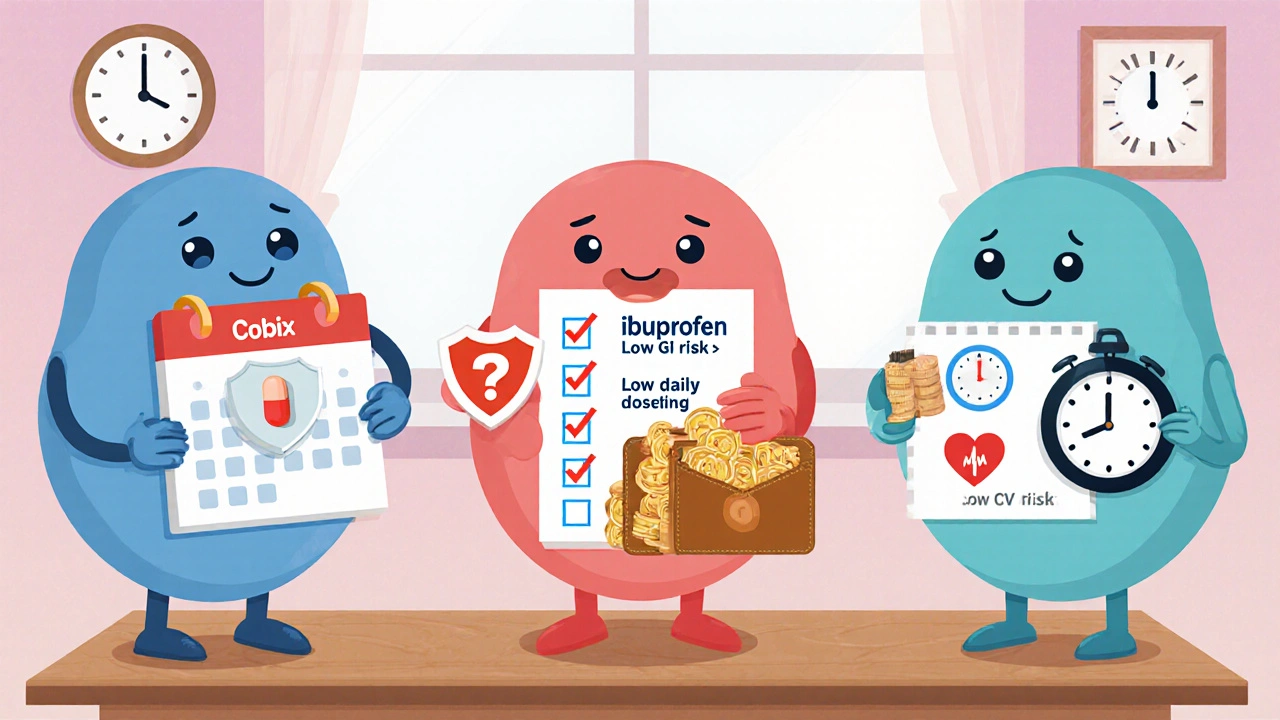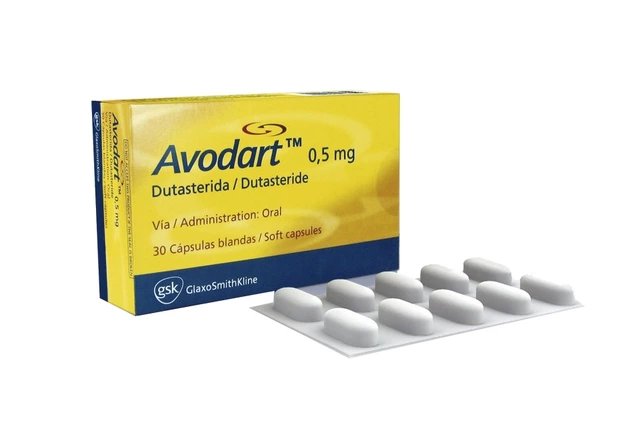NSAID Safety Calculator
Your Recommendations
Enter your health information and click "Calculate My Safe Option" to see your personalized recommendations.
If you’ve heard of Celecoxib, you probably know it’s sold under the brand name Cobix. But how does it really stack up against the classic over‑the‑counter painkillers many people reach for? This guide breaks down the science, safety profile, and practical considerations so you can decide whether Cobix belongs in your medicine cabinet.
Cobix is a branded formulation of celecoxib, a prescription NSAID that selectively blocks the COX‑2 enzyme while sparing COX‑1, the enzyme that protects the stomach lining. The drug is approved for osteoarthritis, rheumatoid arthritis, ankylosing spondylitis, and acute pain after surgery. Typical dosing ranges from 100 mg once daily for chronic conditions to 200 mg twice daily for short‑term flare‑ups.
Celecoxib belongs to the class of COX‑2 selective inhibitors, a subgroup of non‑steroidal anti‑inflammatory drugs (NSAIDs). By focusing on COX‑2, it aims to reduce inflammation and pain without the high gastrointestinal (GI) toxicity seen with non‑selective NSAIDs.
How Celecoxib Works and What Sets It Apart
Traditional NSAIDs like ibuprofen or naproxen inhibit both COX‑1 and COX‑2. COX‑1 produces prostaglandins that protect the stomach lining and support platelet function. Inhibiting COX‑1 can lead to ulcers, bleeding, and kidney issues. Celecoxib’s selective inhibition means fewer stomach complaints, but it also carries a modest increase in cardiovascular (CV) risk, especially at higher doses or in patients with existing heart disease.
Clinical trials have shown that celecoxib provides comparable pain relief to non‑selective NSAIDs for arthritis while causing fewer endoscopic ulcers. However, the drug is metabolized by the liver enzyme CYP2C9, so drug‑drug interactions with certain antidepressants, anticoagulants, and some antihypertensives need careful monitoring.
Key Safety Considerations for Cobix
- GI safety: Lower ulcer risk than ibuprofen, naproxen, or diclofenac.
- Cardiovascular: Slightly elevated risk of heart attack or stroke, particularly with doses >200 mg/day.
- Kidney: Same caution as other NSAIDs; avoid in severe renal impairment.
- Allergy: Rare, but watch for signs of hypersensitivity (rash, swelling).
- Pregnancy: Contra‑indicated in the third trimester.
Common NSAID Alternatives
Below are the most frequently used NSAIDs that people consider instead of Cobix. Each has its own balance of efficacy, GI risk, and CV profile.
Ibuprofen is an over‑the‑counter (OTC) non‑selective NSAID used for mild to moderate pain, fever, and inflammation. Typical adult dose is 200-400 mg every 4-6 hours, not to exceed 1,200 mg without medical supervision.
Naproxen offers longer lasting relief than ibuprofen, with a dosing interval of 12 hours. Standard OTC strength is 220 mg, while prescription doses can reach 500 mg twice daily.
Diclofenac is a potent NSAID often prescribed for joint pain and post‑operative inflammation. It is available as oral tablets (50 mg three times daily) and a topical gel that minimizes systemic exposure.
Meloxicam bridges the gap between selective and non‑selective NSAIDs, offering COX‑2 preference at lower doses (7.5 mg daily) while still providing strong anti‑inflammatory action.
Etoricoxib is another COX‑2 selective drug, marketed in many countries for arthritis and acute pain. Doses range from 60‑90 mg once daily, and it shares a similar CV risk profile to celecoxib.
Side‑by‑Side Comparison
| Drug | Brand | Typical Dose | Onset (hrs) | GI Ulcer Risk | Cardiovascular Risk |
|---|---|---|---|---|---|
| Celecoxib | Cobix | 100‑200 mg daily | 1‑2 | Low | Moderate ↑ |
| Ibuprofen | Advil, Motrin | 200‑400 mg q4‑6h | 0.5‑1 | Medium | Low |
| Naproxen | Aleve | 220‑500 mg BID | 1‑2 | Medium | Low |
| Diclofenac | Voltaren | 50‑75 mg TID | 1‑2 | High | High ↑ |
| Meloxicam | Mobic | 7.5 mg daily | 1‑2 | Low‑Medium | Low‑Medium |
| Etoricoxib | Arcoxia | 60‑90 mg daily | 1‑2 | Low | Moderate ↑ |
Choosing the Right Option for You
Think of the decision as a balancing act between pain control and side‑effect tolerance. Use the following checklist:
- Stomach health: If you have a history of ulcers or are on aspirin/anticoagulants, Cobix’s lower GI risk makes it attractive.
- Heart health: Patients with coronary artery disease, hypertension, or high cholesterol should discuss the modest CV risk of celecoxib (and etoricoxib) with their doctor. Ibuprofen and naproxen generally carry a lower CV signal.
- Kidney function: All NSAIDs can affect renal perfusion; however, short‑term, low‑dose ibuprofen may be safer for mild renal impairment.
- Convenience: Cobix’s once‑daily dosing beats the multiple daily pills required for ibuprofen or diclofenac.
- Cost and access: OTC options (ibuprofen, naproxen) are cheaper and don’t need a prescription, while Cobix requires a doctor’s approval.
Ultimately, the “best” drug depends on your medical history, the intensity of pain, and how you weigh GI versus CV risks.

Practical Tips for Taking Cobix Safely
- Take the tablet with food or a full glass of water to minimize stomach irritation.
- Never exceed the prescribed dose; higher doses increase both GI and CV hazards.
- Inform your doctor about any anticoagulants (warfarin, DOACs) or antidepressants (SSRIs, SNRIs) you’re using.
- Schedule periodic liver function tests if you stay on the medication for more than three months.
- Stop the drug and seek medical help if you notice sudden chest pain, shortness of breath, or signs of bleeding.
Frequently Asked Questions
Can I take Cobix with ibuprofen for extra pain relief?
No. Combining a COX‑2 inhibitor with a non‑selective NSAID raises the risk of stomach bleeding and kidney strain without providing extra pain control. Talk to your doctor about alternative dosing strategies instead.
Is Cobix safe for people with a history of heart disease?
Celecoxib carries a modest increase in cardiovascular events, especially at doses above 200 mg per day. Patients with prior heart attacks, strokes, or uncontrolled hypertension should use it only if the benefit clearly outweighs the risk, and under close medical supervision.
How quickly does Cobix start working?
Most people feel pain relief within 1‑2 hours after the first dose. Full anti‑inflammatory effect may take 3‑5 days of consistent dosing.
Can I take Cobix while pregnant?
No. Celecoxib is contraindicated in the third trimester because it can affect fetal cardiovascular development. If you become pregnant while on the drug, stop it immediately and contact your obstetrician.
What are the main signs of a serious side effect?
Watch for sudden chest pain, shortness of breath, leg swelling (possible clot), black stools or vomiting blood (GI bleed), severe rash, or swelling of the face/tongue (allergic reaction). Seek emergency care if any appear.
By weighing the pros and cons outlined above, you can make an informed choice between Cobix and the more familiar NSAIDs. Always involve your healthcare provider in the final decision, especially if you have chronic conditions or take multiple medicines.







Comments(6)